Ijraset Journal For Research in Applied Science and Engineering Technology
- Home / Ijraset
- On This Page
- Abstract
- Introduction
- Conclusion
- References
- Copyright
Formulation and Evaluation of Poly Herbal Syrup
Authors: Karan D. Atpadkar, Akanksha N. Mote , Vishal H. Pawar, Ketakee S. Patil
DOI Link: https://doi.org/10.22214/ijraset.2025.67006
Certificate: View Certificate
Abstract
Natural antioxidants are broadly distributed in therapeutic plants. These natural antioxidants, particularly polyphenols and carotenoids, exhibit a wide range of organic effects, including anti-inflammatory, 0anti-atherosclerosis and anticancer. An antioxidant is a molecule able of slowing or preventing the oxidation of other molecules. They may ensure cells from harm caused by unsteady particles known as free radicals. Antioxidants terminate these chain responses by evacuating free radical intermediate. Our body is rich in endogenous antioxidants, the substances that have the capacity to stop free radicals’ arrangement or to limit the damage they cause. Low levels of one or more of the fundamental antioxidants have been appeared to be associated with numerous disorders counting cancer, inflammation, atherosclerosis, coronary heart disease and diabetes. These days, a great bargain of effort being used to discover successful antioxidants for the treatment or avoidance of free radical-mediated harmful effects. Cellular damage or oxidative damage arising from free radicals or receptive oxygen species (ROS) now shows up the essential mechanism fundamental a number of human neurodegenerative disorder, diabetes, inflammation, immune system pathologies and digestive framework disorders. As of late there has been developing interest in investigate into the part of plant-derived antioxidants in nourishment and human health. In the nourishment industry, an antioxidant is characterized as a substance that, in little amounts, is able of preventing or delaying, in a critical way, the oxidation of effectively oxidizable materials, such as fats. In unthinking terms, an antioxidant can be defi require as a hydrogen donor or an electron donor.
Introduction
I. INTRODUCTION
Herbal remedies have been utilized for numerous afflictions. Herbal medicine has numerous dynamic constituents for many infections, but proper information must be required to plan herbal details. Something else, the dynamic constituents will be harmed. The public's interest in conventional pharmaceutical has been increasing in later a long time, but conventional herbal pharmaceutical must be converted into modern pharmaceutical to increment patient acknowledgment [18]
Antioxidants or inhibitors of oxidation are compounds which retard or prevent the oxidation and in common prolong the life of the oxidizable matter.[1] The oxidants / free radicals are species with especially brief half-life, tall reactivity and damaging activity towards macromolecules like proteins, DNA and lipids. [2,3] Free radicals are continuously made coming almost in wide harm to tissues and biomolecules driving to diverse disease conditions. So, the therapeutic plants with antioxidant property are utilized as an elective source of pharmaceutical to diminish the illnesses related with oxidative push. [4,5] Over a long time, individuals have been faced with diverse illnesses, trouble and struggles to antagonize it with distinctive approaches. [6,7]
Amongst the different approaches utilized in combatting sicknesses is the utilize of medicinal plants for the treatment of distinctive diseases.[8,9] In spite of the enhancement of diverse major medications, the tilt toward herbal pharmaceutical is picking up energy due to the rising concerns of the expanding toxicities related with essential line therapies.[10,11] In afterward times, the utilize of helpful plants is considered as a complementary and elective medicines in combination with other treatments.[12]
Antioxidants ensure cells from harm caused by free radicals. Antioxidants have been showed up to moderate down or avoid the oxidation of other molecules.[13] They have the capacity to conclusion chain reactions and hinder oxidation reactions and by getting to be oxidized themselves. [14,15] Helpful plants have been fundamentally to ordinary pharmaceutical systems for centuries, valued for their grouped supportive properties.[16] Oxidative stretch, rising from an imbalance between ROS era and the body's antioxidant Défense mechanisms.[17] In the final three a long time, one of the conventional drinks utilized by Banda Aceh, Aceh, Indonesia, is polyherbal syrup to keep up wellbeing and increment insusceptibility. This polyherbal syrup is accepted to keep up the body's essentialness amid the Covid-19 widespread. The capacity of the polyherbal syrup to keep up a solid body is suspected of coming from the phytochemical substance that acts as an antioxidant. Antioxidants are compounds that can offer assistance boost the safe framework by authoritative to highly receptive atoms. Normally, the human body has an antioxidant framework to ward off free radicals reasonably. Be that as it may, if the number of free radicals in the body is excessive, extra antioxidants are required [19] the syrup is one sort of drink that is much preferred by the open so it has a exceptionally ensured showcase potential. The syrup is a kind of delicate drink in the form of a thick sugar arrangement with different flavours.[20]
Terminalia arjuna, commonly known as arjuna, has a place to the family Combretaceae. Arjuna is a effective herb that has been broadly utilized in Ayurvedic medication for a exceptionally long time. Since of its strong cardioprotective and cardioprotective impacts, it is basically utilized to treat heart disease.[21] Since old times, individuals have utilized the therapeutic powers of arjuna bark to treat a assortment of ailments.[22] Arjuna is a surprising herb that advances heart wellbeing and facilitates the impacts of anxiety and uncertainty.[23] It moves forward cardiovascular health and controls heart rate.
Moringa oleifera Lamarck (Moringa) is the developed species of the class Moringa of the family Moringaceae [24]. Is a perennial tropical deciduous tree with tall financial and pharmaceutical value? As an eatable plant, M. oleifera Lam. Is wealthy in supplements, such as proteins, amino acids, mineral components and vitamins. Other than, it too contains a critical number of bioactive phytochemicals, such as polysaccharide.
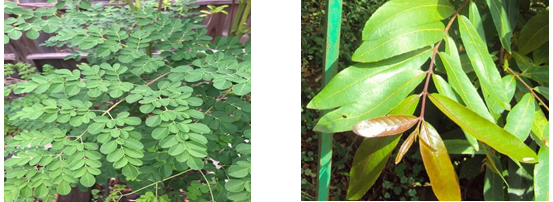
Fig 1- Moringa oleifera Fig 2 - Terminalia arjuna
II. MATERIALS AND METHODS
A. Collection
Moringa oleifera and terminalia were collected and authenticated from SGM college Karad, Satara, Maharashtra.
B. Chemicals
Dexamethasone sodium phosphate (99.5 %), Orange oil, EDTA. Saccharin Sodium (99 %), Sucrose (99 %), Glycerine (99 %), Red colour, Moringa oleifera, Terminalia arjuna, distilled water.
III. EXTRACTION
A. Moringa oleifera
Powdered dried leaves (5 g) were extracted by maceration with 100 mL methanol 70% for 72 h at room temperature with intermittent shaking. The arrangement was sifted with Whatman filter paper and the filtrate was evaporated to get a dry extract utilizing three evaporation strategies: in the light (i) with discuss evaporation at room temperature beneath hood for 24 h; (ii) evaporation with rotary evaporator beneath diminished weight at 40 °C for 6 h; (iii) evaporation in the dark in oven at 40 °C for 2 h. All extracts were arranged in triplicate.[25]

Fig 3
B. Terminalia arjuna
TA extract was gotten from this powder by extracting it with alcohol (50 mL/100 mL water) at 5°C for 72 h. The extract was advance sifted and the reddish-brown syrupy mass in this way gotten was at long last dried in a tray drier at 50°C to get the last item. The yield of alcoholic extract was around 14.5 g/100 g and it was stored in amber-coloured bottles at 4°C until utilize.
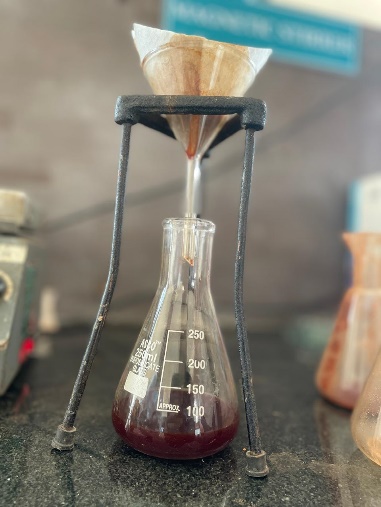
Fig 4
IV. MATERIALS USED
|
Component |
Quantity/100 ml |
Functions |
|
Dexamethasone sodium phosphate (99.5 %) |
13.0 mg |
Active ingredient |
|
Orange oil |
102.5 mg |
Flavour |
|
EDTA |
0.1 g |
Chelating agent |
|
Saccharin Sodium (99 %) |
33 mg |
Sweetening agent |
|
Sucrose (99 %) |
50 g |
Sweetening agent |
|
Glycerine (99 %) |
2.6 ml |
Preservative |
|
Distilled water |
100.0 ml |
Solvent |
|
Red colour |
5.3 mg |
Colouring agent [26] |
|
Moringa oleifera |
2mg |
Herbal plant |
|
Terminalia arjuna |
2mg |
Herbal plant |
Table 1
A. Formulation
The product was prepared where it contains 13mg of dexamethasone sodium phosphate. 1L of distilled water and heated at 50o C. After that sucrose was added around 50g and for 15 min heating was continued. After that EDTA 0.1gm was mixed with glycerine for 2 min, EDTA was mixed with distilled water around 50ml water and then mix it in the solution and heated again for 5 mins, after that red colour was added 5.3mg and saccharin sodium 33mg was added in it. For flavouring agent orange oil was used 0.12ml. and heated for around 1 min. after that 100ml cold water was taken in that dexamethasone sodium phosphate was added and then this was mix with each other and boil for 5 min. [26]
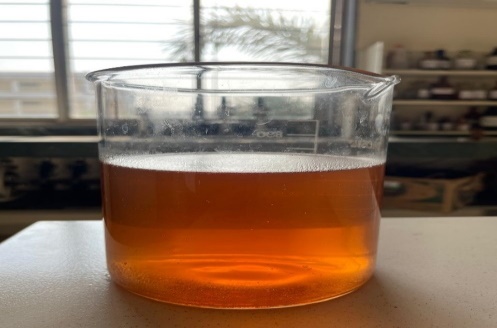
Fig 5
V. EVALUATION TESTS FOR SYRUP
A. Specific Gravity
Specific gravity was evaluated by the formula as given below Specific gravity of liquid under test(syrup)=weight of liquid undertest/weight of water=w5/w4.
B. Viscosity
viscosity= Density of test liquid × Time required to test liquid X viscosity water
Density of water × Time required to flow water
C. pH Determination
The pH determination of syrup by digital pH meter. Take 10 ml of final syrup in the volumetric flask and make up the volume up to 100 ml with distilled water. The pH was measured by using digital pH meter
D. Colour
Colour examination is done by observing the syrup directly with our naked eye.
E. Odour
5 ml of final syrup was smelled individually then the odour can be detected.
VI. PHYTOCHEMICAL TESTS
A. Moringa oleifera
|
Sr no. |
Tests |
Observations |
|
|
Detection of Alkaloids |
|
|
|
Dragendroff’s tests |
+ |
|
|
Wagner’s test |
+ |
|
|
Iodine test |
+ |
|
|
Mayer’s reagent |
- |
|
|
Detection of Flavonoids |
|
|
|
Ferric chloride tests |
+ |
|
|
Alkaline reagent test |
+ |
|
|
Lead acetate test |
+ |
|
|
Ammonia solution |
+ |
|
|
Detection of phenols |
|
|
|
Iodine test |
+ |
|
|
Ferric chloride test |
+ |
|
|
Lead acetate test |
+ |
|
|
Potassium dichromate test |
+ |
|
|
Detection of triterpenoids |
|
|
|
Salkowski’s test |
+ |
|
|
Detection of Carbohydrates |
|
|
|
Barford’s test |
- |
|
|
Molish test |
+ |
Table 2

Fig 6 Fig 7
B. Terminalia arjuna
|
Sr no. |
Tests |
Observations |
|
|
Detection of Alkaloids |
|
|
|
Dragendroff’s tests |
+ |
|
|
Wagner’s test |
+ |
|
|
Mayer’s reagent |
+ |
|
|
Detection of Flavonoids |
|
|
|
Ferric chloride tests |
+ |
|
|
Alkaline reagent test |
- |
|
|
Lead acetate test |
+ |
|
|
Detection of phenols |
|
|
|
Ferric chloride test |
+ |
|
|
Lead acetate test |
+ |
|
|
Detection of Carbohydrates |
|
|
|
Barford’s test |
- |
|
|
Molish test |
- |
Table 3

Fig 8 Fig 9
VII. RESULT
The resulting syrup is delicious! It is defined as a thick, sticky liquid consisting of a concentrated solution of sugar and water with or without added flavouring or medicinal ingredients [26-28] Added sweeteners can also help enhance the taste of certain herb.
Secondary constituents are the chemicals consisting of alkaloids, flavonoids, terpenes, phenolics, saponins, glucosides. [29,30] Of these secondary constituents phenolics are seen to be the most numerous consisting of 45% of the secondary phytochemical constituents of plants, terpenoids27%, alkaloids 18% and others 10%. [31]
Phytochemicals possess nutraceutical importance. [32,33] They are the bioactive constituents that maintain health and serve as a bridge between the food and pharmaceutical industries. Phytochemicals perform numerous functions. They possess unique pharmacological effects such as antiinflammatory, anti-allergic, antioxidants, antibacterial, antifungals, neuroprotective, hypotensive, antiaging.
|
Parameter |
Result |
|
Specific gravity |
1.013 |
|
Viscosity |
3660 Cp |
|
pH |
7.49 |
|
Colour |
Orange |
|
Odour |
Aromatic |
|
Taste |
Sweet |
|
Appearance |
Turbid |
Table 4
A. Specific Gravity
Specific Gravity was evaluated by the formula as given below,
Weight of empty bottle -23.49g
Weight of Syrup filled bottle- 48.86g.
Weight of water filled bottle- 48.51g
Formula: specific gravity = (weight of syrup-filled bottle – weight of empty bottle) / (weight of water-filled bottle-weight of empty bottle).
Formulated syrup Specific gravity is 1.013.
B. Viscosity
Viscosity was determined by the spindle no4.
The formulated syrup viscosity was 3660 cp observed.
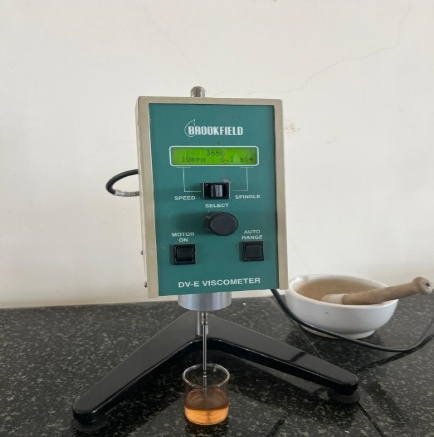
Fig 10
C. pH
The formulated syrup pH was 7.49 observed, which is slightly alkaline.
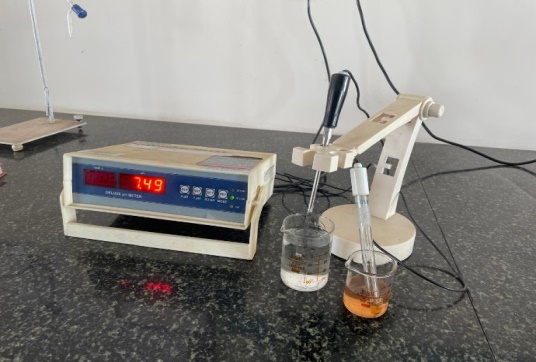
Fig 11
D. Colour
The colour of formulated syrup was orange observed.
E. Appearance
All the details of syrup were turbid in colour.
VIII. DISCUSSION
In today’s era the herbal products are the symbol of safety in contrast to the synthetic drugs which are regarded as unsafe to human being and environment. Although, herbs had been priced for their medicinal, flavouring and aromatic qualities for centuries. It’s time to promote them globally. The prepared herbal syrup is having anti-oxidant activity. [34]. The formulation having antioxidant property hence it will be very helpful for researchers as well as industries to make the similar formulations on large scale.[35]
Scientific advancements have refined phytoconstituents these formulations by exploring and identifying synergistic herbal combinations, enhancing their efficacy as credible alternatives to allopathic drugs [36].
Conclusion
Based on the results of the consider with physical tests and the combination of Moringa oleifera, Terminalia arjuna was carried out. The definition having antioxidant property thus it will be exceptionally helpful for antioxidant potential of medicinal plant species holds immense promise for preventive and therapeutic applications in cutting edge healthcare. In conclusion, the investigation of medicinal plant antioxidants reveals a wealthy source of bioactive compounds with the potential to advance health and prevent disease. Coordination conventional herbal medication with conventional therapeutic practices presents opportunities for synergistic approaches to healthcare. The engineered antioxidants right now utilized in the nourishment industry have been found to have a few malignant health effects. In that sense, there is an expanding interest in common antioxidants, particularly plant-derived antioxidant com pounds. Conventional medication uses a assortment of time-tested medicinal plants that are effective for a wide range of sicknesses. For the advancement of the polyherbal syrup in the current examination, the leaves of Moringa oleifera and terminalia arjuna were utilized.
References
[1] Kokate C.K.(a), Purohit A.P., “Text book of pharmacognosy”, 2004, 29, pp.542 [2] Kokate C.K.(b), Purohit A.P., “Text book of pharmacognosy”, 2004, 29, pp.317-18, 336-37. [3] Hussain EHMA, Jamil K and Rao M. Hypoglycaemics, hypolipidemic and antioxidant properties of Tulsi (Ocimum sanctum) on streptozotocin induced diabetes in rats. Indian J of Clin Biochemistry, 2001; 16(2): 190-194 [4] Prajapati Narayan Das, Purohit S.S., Sharma A.K., Kumar Tarun, A hand book of Medicinal Plants, Agrobios (India), ISBN-81-7754-134-X. [5] Zhang Donglin and Hamauzu Yasunori, Phenolic compound and their antioxidant properties in different tissue of carrot, international journal of food, agriculture and environment 2002, (asianfood.info). [6] Picard, M.; McEwen, B. S. Psychological Stress and Mitochondria: A Systematic review Psychosomatic Med.2018,80,141–153.DOI:10.1097/PSY.0000000000000545. [7] Ferroni, P.; Barbanti, P.; Della-Morte, D.; Palmirotta, R.; Jirillo, E.; Guadagni, F. Redox Mechanisms in Migraine: Novel Therapeutics and Dietary Interventions. Antioxidants Redox Signal. 2018, 28, 1144–1183. DOI: 10.1089/Ars. 2017.7260 [8] Lawal, B.; Shittu, O. K.; Obiokpa, F. I.; Berinyuy, E. B.; Mohammed, H. African Natural Products with Potential Antioxidants and Hepatoprotectives Properties: A Review. Clinical Phyto science 2016, 2–23. DOI: 10.1186/s40816- 016-0037-0. [9] Kruk, J.; Hassan, Y. A.-E.; Kladna, A.; Jacquelyn, E. B. Oxidative Stress in Biological Systems and Its Relation with Pathophysiological Functions: The Effect of Physical Activity on Cellular Redox Homeostasis. Free Radical Res. 2019, 53(5), 497–521. DOI: 10.1080/10715762.2019.1612059. [10] Akram, M.; Hamid, A.; Khalil, A.; Ghaffar, A.; Tayyaba, N.; Saeed, A.; Ali, M.; Naveed, A. Review on Medicinal Uses, Pharmacological, Phytochemistry and Immunomodulatory Activities of Plants. Int. J. Immunopathology. Pharmacology 2014, 27(3), 313–319. DOI: 10.1177/039463201402700301. [11] Khalid, W.; Arshad, M. S.; Aslam, N.; Mukhtar, S.; Rahim, M. A.; Ranjha, M. M. A. N.; Noreen, S.; Afzal, M. F.; Aziz, A.; Awuchi, C. G. Food Applications of Sorghum Derived Kafirins Potentially Valuable in Celiac Disease. Int. J. Food Prop. 2022, 25(1), 2348–2363. DOI: 10.1080/10942912.2022.2135532 [12] Kawamura, T.; Muraoka, I. Exercise-induced Oxidative Stress and the Effects of Antioxidant Intake from a Physiological Viewpoint. Antioxidants. 2018, 7(9), 119. DOI: 10.3390/antiox7090119. [13] Goodarzi, S.; Rafiei, S.; Javadi, M.; Khadem, H. H.; Norozi, S. A. A Review on Antioxidants and Their Health Effects. J. Nutritional Food Secure. 2018, 3(2), 106–112 [14] Yasueda, A.; Urushima, H.; Ito, T. Efficacy and Interaction of Antioxidant Supplements as Adjuvant Therapy in Cancer Treatment: A Systematic Review. Int. Cancer. Therapies. 2016, 15(1), 17–39. DOI: 10.1177/ 1534735415610427. [15] Awuchi, C. G.; Okpala, C. O. R. Natural Nutraceuticals, Especially Functional Foods, Their Major Bioactive Components, Formulation, and Health Benefits for Disease Prevention-an Overview. J. Food Bioactive. 2022, 19. DOI: 10.31665/JFB.2022.18317. [16] Sarbadhikary, P.; George, B.P. A Review on Traditionally Used African Medicinal Plant Annickia chlorantha, Its Phytochemistry, and Anticancer Potential. Plants 2022, 11, 2293. https://doi.org/10.3390/plants11172293 [17] Dar, R. A., Shahnawaz, M., Ahanger, M. A., & ul Majid, I. (2023). Exploring the Diverse Bioactive Compounds from Medicinal plants; A review: The journal of Phytopharmacology, 12, 189-195. [18] M. Rezghi, S. Alireza Mortazavi, R. Choopani, and S. Fahimi, “Formulation of a Traditional Polyherbal Product to a Standard Pharmaceutical Syrup and Development of Its Quality Control Methods Developing a Clinical Presentation Curriculum (CPC) View project Persian Medicine View project,” Res. J. Pharmacognosy, vol. 6, no. 4, pp. 53–59, 2018. [19] R. Rahmawati, A. Muflihunna, and L. M. Sarif, “analysis activities antioxidant produces syrup bush men kudu (Morinda citrifolia L.) Dengan method dpph,” J. Fitofarmaka Indonesia., vol. 2, no. 2, pp. 97–101, 2016 [20] Eslaminejad T, and Zakaria M. (2011). Morphological characteristics and pathogenicity of fungi associated with Roselle (Hibiscus sabdariffa L.) diseases in Penang, Malaysia: Microbial Pathogenesis, 51(5): 325-337. [21] Bishop S, LiuSJ. Cardio protective action of the aqueous extract of Terminalia arjuna bark against toxicity induced by doxorubicin. Phytomedicine.2017;36:210–216. 4. Maulik S, KatiyarK. Terminalia arjuna in cardiovascular diseases: making the transition from traditional to modern medicine in India. CurrPharmBiotechnol.2010;11(8):855–60. [22] Sekhar YC, Kumar GP, Anil a Kumar KR. Terminalia arjuna bark extract attenuate picrotoxin- induced behavioural changes by activation of serotonergic, dopaminergic, GABAergic and antioxidant systems. ChineseJNaturalMed.2017;15(8):584–96. [23] Khanna AK, Chander R, Kapoor NK. Terminalia arjuna: an ayurvedic cardiotonic, regulates lipid metabolism in hyperlipaemia rats. Phytotherapy Res.1996;10(8):663–8. [24] Rajamanickam M, Kalaivanan P, Sivagnanam I. Evaluation of Anti-oxidant and Anti-diabetic Activity of Flower Extract of Clitoria ternatea L. [25] Pravin Digambar Sawale, Release characteristics of polyphenols from microencapsulated Terminalia arjuna extract: Effects of simulated gastric fluid. International journal of food properties 2017, VOL. 20, NO. 12, 3170–3178. [26] Aziz A, Khan IA, Afzal A, Munawar SH. Formulation and evaluation of herbal Antitussive syrup of methanolic extract of Lycopus europaeus in mice. AmJ Pham HealthRes.2013;1(8):121–9. [27] sheikh ZA, Zahoor A, Khan SS, Usmanghani K. Design, Development and Phytochemical Evaluation of a Poly Herbal Formulation Link us Syrup. ChinMed.2014;5(2):1–9. [28] Jadhav A G, Sanap. MJ, Patil PA. Formulation and Evaluation of Herbal Syrup.AsianJPharmResDev.2021;15(3):16–22. [29] Awuchi, C. G.; Twinomuhwezi, H.,2021. The Medical, Pharmaceutical, and Nutritional Biochemistry and Uses of Some Common Medicinal Plants. In Medicinal and Aromatic Plants of the World, Eds., Ozturk, M., Ameenah, G. F. B., Encyclopaedia of Life Support Systems (EOLSS), Developed under the Auspices of UNESCO, ELOSS Publishers, Paris, France, 1–32pp. Available at https://www.eolss.net/Sample-Chapters/C03/ E6-79a-14.pdf (accessed May 25, 2022). [30] Zahnit, W.; Smara, O.; Bechki, L.; Souici, C. B.; Messaoudi, M.; Benchikha, N.; Larkem, I.; Awuchi, C. G.; Sawicka, B.; Simal-Gandara, J. Phytochemical Profiling, Mineral Elements, and Biological Activities of Artemisia Campestris L. Grown in Algeria. Horticulture. 2022, 8(10), 914. DOI: 10.3390/horticulturae8100914. [31] Prakash, D.; Upadhyay, G.; Pushpangadan, P.; Gupta, C. Antioxidant and Free Radical Scavenging Activities of Some Fruits. J. Complement. Integr. Med. 2011, 8(1). DOI: 10.2202/1553-3840.1513. [32] Palai, S.; Kesh, S. S.; Awuchi, C. G.; Sirajuddin, A. A.; Egbuna, C. Role of Phytochemicals in the Treatment of Ectoparasitic Infections: Scabies and Myiasis. In Neglected Tropical Diseases and Phytochemicals in Drug Discovery; Egbuna, C., Akram, M., Ifemeje, J. C., Eds.; Wiley: New Jersey, 2021; pp 477–498. DOI: 10.1002/ 9781119617143.ch20. [33] Nazer, M. R.; Abbaszadeh, S.; Anbari, K.; Shams, M. A Review of the Most Important Medicinal Herbs Affecting Giardiasis. J. Herb med Pharmacology 2019, 8(2), 78–84. DOI: 10.1517/jhp.2019.13. [34] Dr. Javesh K. Patil, formulation and evaluation of herbal syrup, World Journal of Pharmaceutical Research. Volume 8, Issue 6, 1061-1067. DOI: 10.20959/wjpr20196-14867. [35] Amit Gajanan Nerkar, Formulation and evaluation of herbal syrup of Arjuna extract, Current Trends in Pharmacy and Pharmaceutical Chemistry 2023;5(2):75–78. [36] Dahanukar S, Thatte UM. Current status of ayurveda in phytomedicine. Phytomedicine. 1997;4(4):359-368. DOI:10.1016/S0944-7113(97)80048-7. [37] Fuad Al-Rimawi, Evaluation of the effectiveness of natural extract as a substituent for synthetic preservatives and antioxidants in pharmaceutical preparations, Saudi Pharmaceutical Journal 32 (2024) 102014. [38] Shreeyash Kotmire, The advances in polyherbal formulation, Journal of PharmacognosyandPhytochemistry2024;13(1):210221,DOI: https://doi.org/10.22271/phyto.2024.v13.i1c.14828. [39] Parvin Shaikh, Formulation and evaluation of antidiabetic polyherbal syrup, Journal of PharmacognosyandPhytochemistry2024;13(2):1017,DOI: https://doi.org/10.22271/phyto.2024. v13.i2a.14865. [40] Putri Nata Sari, Formulation and Physical Evaluation of the Combination Syrup of Rosella (Hibiscus sabdariffa L.) and Lemongrass (Cymbopogon citratus), Journal Kebidanan dan Kesehatan Traditional Volume. 8, Number. 1, March 2023 https://doi.org/10.37341/jkkt.v8i1.461. [41] Khaled Rashed, Medicinal Plants with antioxidant Potential: A review Hygeia J.D.Med.6 (1) April 2014; 106-110. [42] Onyenibe Sarah Nwozo, Antioxidant, phytochemical, and therapeutic properties of medicinal plants: a review, International Journal of Food Properties. DOI: 10.1080/10942912.2022.2157425. [43] Shikhar Katiyar, Some Indian Traditional Medicinal Plants with Antioxidant Activity: A Review, International Journal of Innovative Research in Science, Engineering and Technology, Vol. 2, Issue 12, December 2013, ISSN: 2319-8753 [44] Nazmin Sultana, Exploring the Antioxidant Potential of Medicinal Plant Species: A Comprehensive Review, Journal of Plant Biota. DOI: https://doi.org/10.51470/JPB.2023.02.02.09 [45] M. G. Miguel, Antioxidant activity of medicinal and aromatic plants. A review. flavour and fragrance journal,2 November 2009; DOI 10.1002/off .1961. Flavour Fragr. J. 2010, 25, 291–312. [46] Wagh Jyoti G, Preparation and Evaluation of Polyherbal Syrup Containing Extracts of leaves of Moringa Oleifera and the rhizomes of Curcuma longa Linn., Eur. Chem. Bull. 2023, 12(Special Issue 4), 10382-10390. [47] Neha Nikhade, A Review of Natural Antioxidants in Medicinal Plants, international journal of pharmaceutics & drug analysis vol.7, issue 2, 2019; 11 - 15; http://ijpda.com; ISSN: 2348-8948.
Copyright
Copyright © 2025 Karan D. Atpadkar, Akanksha N. Mote , Vishal H. Pawar, Ketakee S. Patil. This is an open access article distributed under the Creative Commons Attribution License, which permits unrestricted use, distribution, and reproduction in any medium, provided the original work is properly cited.

Download Paper
Paper Id : IJRASET67006
Publish Date : 2025-02-18
ISSN : 2321-9653
Publisher Name : IJRASET
DOI Link : Click Here
 Submit Paper Online
Submit Paper Online

